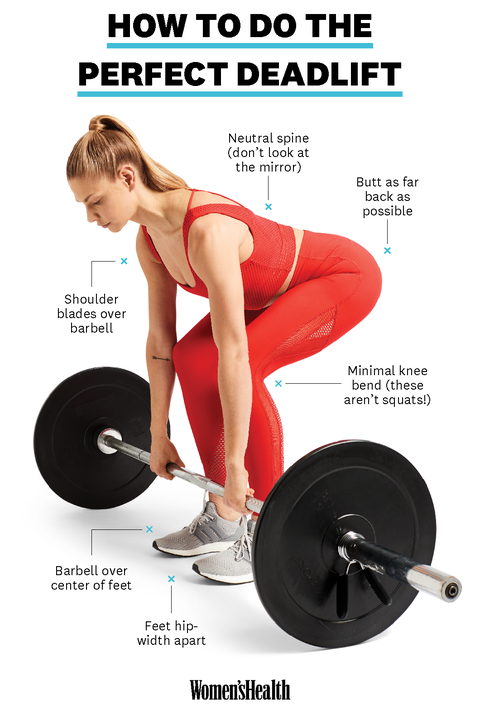Do This Move At The Gym And You’ll Feel Like The Ultimate Badass
I don’t know a more epic way to show off your strength than picking up 100, 150, even 200-plus pounds from a weight-room floor. Which is just one of the reasons we’re obsessed with deadlifts. And we’re not alone. “Now that research shows it’s a myth that women shouldn’t lift heavy [Editor’s note: hooray!], I find more and more women are curious to try deadlifting,” says women’s strength coach Allison Tenney, CSCS. “Then they get excited about it, and then they’re hooked—not just on the physical benefits but on feeling strong, capable, and empowered as well.”
The classic strength exercise engages one of the most innate human movement patterns (hinging forward at the hips) and sculpts everything from the glutes and hammies to the core, lats, and shoulders. It also lets you move more pounds than you can with almost any other exercise and uses all of your muscles. (Tapping so many body parts at a high intensity = serious results.) Hello, newfound sense of power!
Still not convinced? Here are six of the biggest payoffs you’ll get from making this move part of your regular routine:
- Amped Athleticism. Whether you’re running marathons or shooting baskets, deadlifts will make you better. “Deadlifts build power, the lifeblood of any successful athlete,” says Tenney. The hip hinge (pushing your butt back, then thrusting hips forward) is your body’s ultimate force move, propelling running strides, jumps, and other lifts.
- Superior Cardio. Women who performed heavy strength training improved their blood pressure more than those who stuck with cardio, according to an Appalachian State University study. That may be because lifting can act as super-high- intensity interval training, prepping your arteries to dilate more easily. (Buh-bye, elliptical sessions!)
- Stronger Bones. You have to put weight on bones to strengthen them. Luckily, deadlifts let you load the spine and hips (which are prone to osteoporosis) with multiple times your body weight. After each lift, cells called osteoblasts fill in any stressed areas of your skeleton. Once those spots are calcified, they turn to rock-hard bone.
- Tighter Core. Deadlifts beat the plank when it comes to training the deepest muscle in the abs, according to a study in the International Journal of Sports Physical Therapy. Known as the transverse abdominis, it acts as an internal corset, keeping your torso strong and firm.
- Easier Fat Loss. By working every muscle and jacking up your heart rate, deadlifts burn major calories both in the gym and after you cool down, through excess post- exercise oxygen consumption (EPOC), says physical therapist and strength coach Mariel Schofield, DPT, CSCS. EPOC refers to the energy your body uses in the recovery process.
- Glorious Glutes. Deadlifts are a hip-dominant move: Your glutes and hamstrings are doing the brunt of the work with each rep, Tenney says. That means they should be a mainstay of any butt workout—adding size and shape to the area for a visual perk.

Women’s Health
How to deadlift
- Skim the bar up your legs as you push the floor away.
- Stand as tall as possible, keeping your spine neutral.
- Control your pace and hold your back straight as you lower the bar down your legs.
- Bear in mind: The lowering is as important as the raising (don’t drop the bar!).
You don’t have to stick to just the classic, either. Here are four simple variations on the conventional barbell deadlift you can mix into your routine.
1. Staggered-Stance Kettlebell Deadlift
This single-leg switcheroo helps improve stability, balance, and oblique strength and will ID any strength differences between sides.
How to: Grab a kettlebell with your left hand and stand with your right foot planted about a foot in front of your right. Keeping your back flat and chest upright, hinge forward at the hips to lower the weight toward the floor, keeping a soft bend in both knees. Pause, then squeeze your glutes to return to stand. That’s one rep. Do all reps, then switch sides and repeat.
2. Sumo Barbell Deadlift
By spacing your feet farther apart, you put even more emphasis on the glutes as opposed to the quads.
How to: Position your feet wider than hip-width, toes pointing out slightly. Bend at the knees and hips to grasp the bar with both hands just inside your knees (using a mixed grip—one overhand, one underhand—can help with grip strength). Perform the deadlift the same way you would a conventional barbell deadlift.
3. Hex-Bar Deadlift
Easier to get into, this squatty deadlift targets your quads more than conventional deadlifts do, according to research from California State University at Fullerton.
How to: Step into the middle of the hex bar and place your feet hip-width apart, then push your butt back and bend your knees to lower your body to grab grasp the handles at your sides, keeping your spine neutral. From this position, push the floor away from you as you stand as tall as possible. Pause, then slowly lower back to start.
4. Dumbbell RDL
An ideal variation for at-home workouts when you have only dumbbells. It’s also great for newbies who might not be able to deadlift 45 pounds (a bar’s weight without plates) yet.
How to: Hold a dumbbell in both hands, palms facing your thighs and feet shoulder-width apart. Keeping your core tight and spine neutral, push your butt back and hinge forward at the hips, bending your knees slightly as you lower the weights toward your shins. When you feel a stretch in your hamstrings, stop and reverse the movement, squeezing your glutes to return to standing.
This article originally appeared in the April 2019 issue of Women’s Health. For more intel on how to live a happier, healthier life, pick up an issue on newsstands now.
Source: Read Full Article


